Consumer Concern and Willingness to Pay for Plastic Alternatives in Food Service
Abstract
:1. Introduction
2. Materials and Methods
2.1. Survey Instrument and Implementation
2.2. Analyses
- 10.
- I care about Gulf Coasts’ environmental well-being
- 11.
- Plastic pollution is a problem along the Gulf Coast
- 12.
- I am concerned about plastic pollution on the Gulf Coast
- 13.
- Plastic pollution is harmful to marine life (fish, turtles, dolphins, other animals)
- 14.
- Plastic pollution can affect the quality and production of seafood
- 33.
- If restaurants were to increase their prices to switch to environmentally friendly alternatives for eating in only, how much would you be willing to pay per person per meal?
- 34.
- If restaurants were to increase their prices to switch to environmentally friendly alternatives for takeout or delivery only, how much would you be willing to pay per person per meal?
3. Results
3.1. Survey Respondents
3.2. Environmental Concern and Willingness to Pay
3.3. Factor Analysis
3.4. Regression Model
4. Discussion
5. Conclusions
Author Contributions
Funding
Institutional Review Board Statement
Informed Consent Statement
Data Availability Statement
Acknowledgments
Conflicts of Interest
Appendix A. Survey

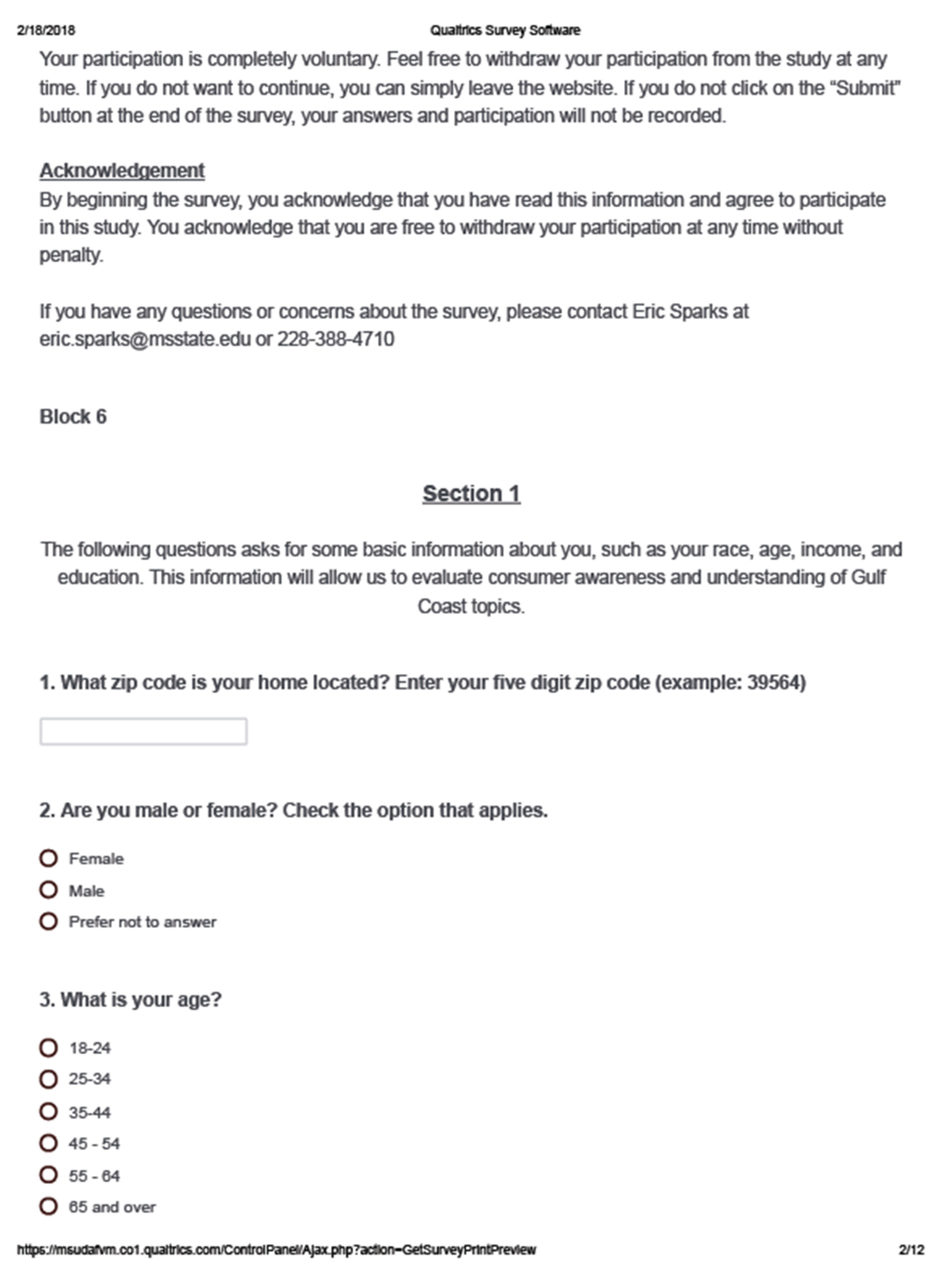





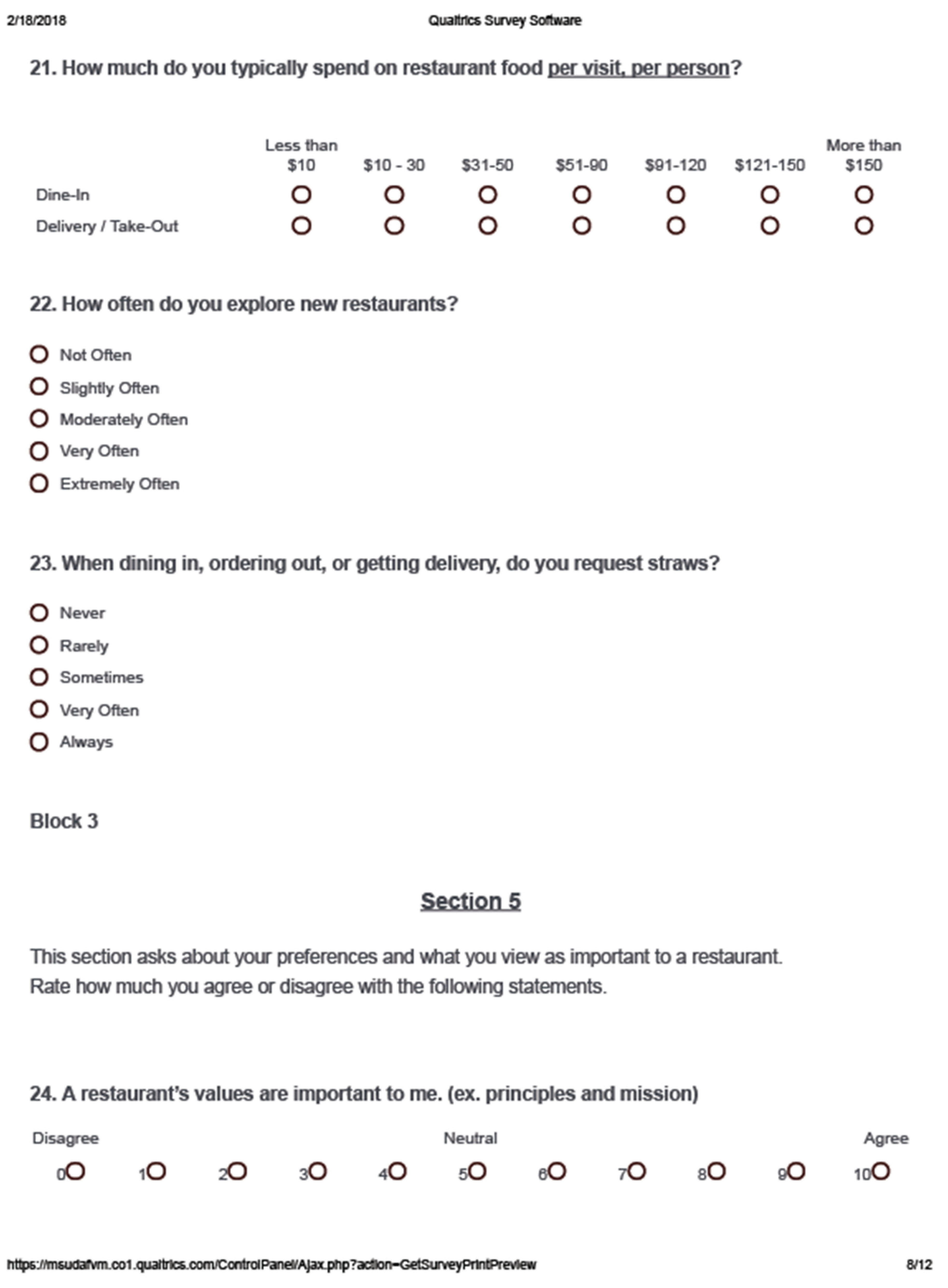

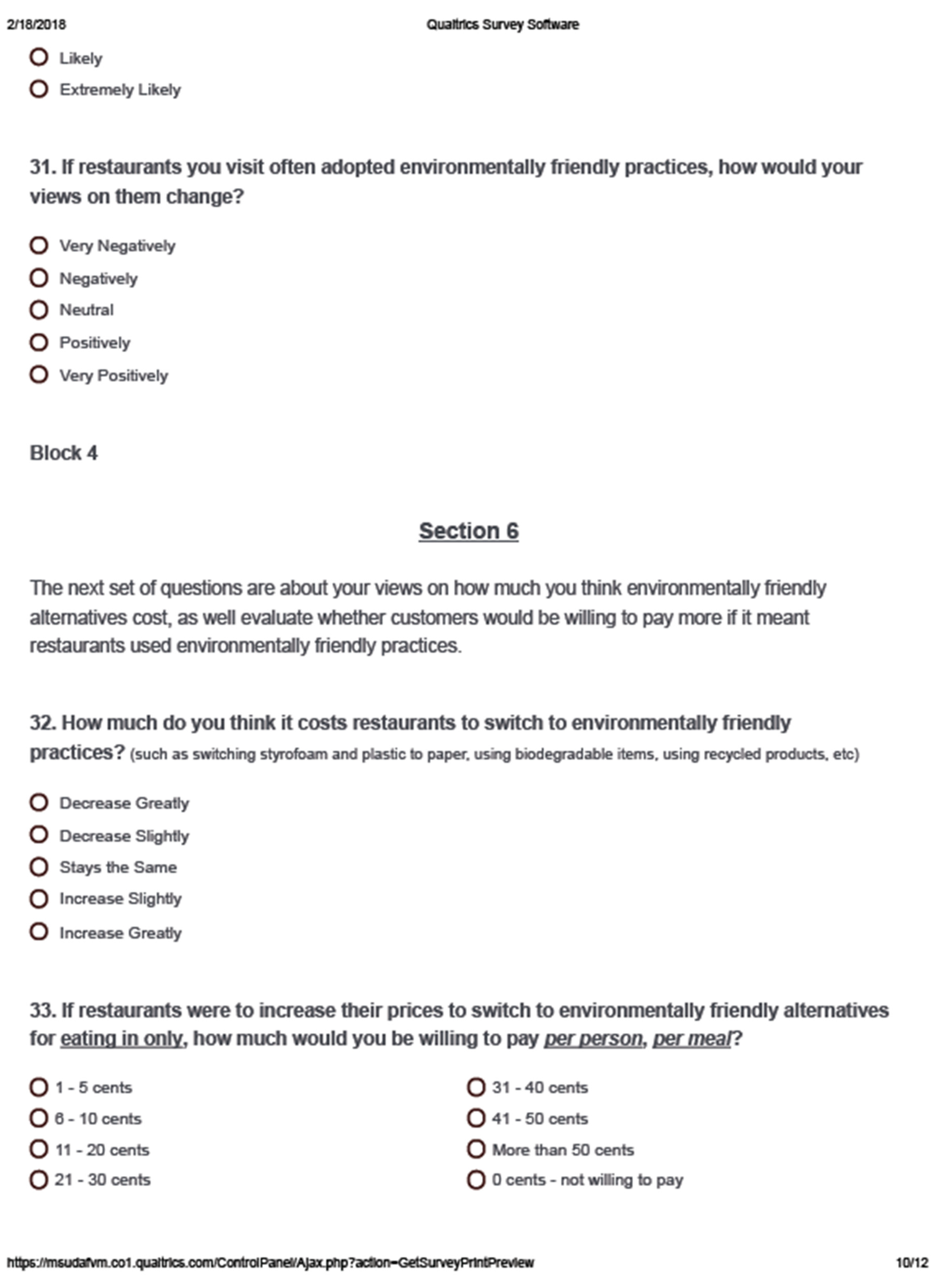

References
- Zalasiewicz, J.; Waters, C.N.; Do Sul, J.A.I.; Corcoran, P.L.; Barnosky, A.D.; Cearreta, A.; Edgeworth, M.; Gałuszka, A.; Jeandel, C.; Leinfelder, R.; et al. The geological cycle of plastics and their use as a stratigraphic indicator of the Anthropocene. Anthropocene 2016, 13, 4–17. [Google Scholar] [CrossRef] [Green Version]
- National Academies of Sciences, Engineering, and Medicine. Reckoning with the US Role in Global Ocean Plastic Waste; The National Academies Press: Washington, DC, USA, 2021. [Google Scholar]
- Barnes, D.K.; Galgani, F.; Thompson, R.C.; Barlaz, M. Accumulation and fragmentation of plastic debris in global environments. Philos. Trans. R. Soc. Lond. B Biol. Sci. 2009, 364, 1985–1998. [Google Scholar] [CrossRef] [PubMed] [Green Version]
- Sparks, E.; Fischbach, E.; Sartain, A. Mississippi Coastal Cleanup 2017; Mississippi State University Extension Service. Agricultural Communications. Publication 3061 (04-17) MASGP-17-014; Mississippi State University: Mississippi State, MS, USA, 2017. [Google Scholar]
- Sparks, E.; Sartain, A.; Baker, B. Mississippi Coastal Cleanup 2018; Mississippi State University Extension Service. Agricultural Communications. Publication 3188 (02-18) MASGP-18-004; Mississippi State University: Mississippi State, MS, USA, 2018. [Google Scholar]
- Sartain, A.; Sparks, E.; Baker, B. Mississippi Coastal Cleanup 2019; Mississippi State University Extension Service. Agricultural Communications. Publication 3312 (01-19) MASGP-19-004; Mississippi State University: Mississippi State, MS, USA, 2019. [Google Scholar]
- Sartain, A.; Sparks, E.; Baker, B. Mississippi Coastal Cleanup 2020; Mississippi State University Extension Service. Agricultural Communications. Publication 3420 (POD-02-20) MASGP-20-004; Mississippi State University: Mississippi State, MS, USA, 2020. [Google Scholar]
- Sartain, M.; James, J.; Rodolfich, A.; Chenier, K.; Sparks, E.; Baker, B. Mississippi Coastal Cleanup 2021; Mississippi State University Extension Service. Publication 3588 (POD-03-21) MASGP-20-004; Mississippi State University: Mississippi State, MS, USA, 2021. [Google Scholar]
- Sartain, M.; James, J.; Rodolfich, A.; Chenier, K.; Englebretson, E.; Mallon, E.; Sparks, E.; Baker, B. Mississippi Coastal Cleanup 2022; MASGP-21-004; Mississippi State University: Mississippi State, MS, USA, 2022. [Google Scholar]
- Ocean Conservancy. Newsroom a Voice for Our Ocean. Top Ten Items. Available online: https://oceanconservancy.org/news/top-ten-items/ (accessed on 12 April 2022).
- Herrmann, C.; Rhein, S.; Sträter, K.F. Consumers’ sustainability-related perception of and willingness-to-pay for food packaging alternatives. Res. Conserv. Rec. 2022, 181, 106219. [Google Scholar] [CrossRef]
- Ketelsen, M.; Janssen, M.; Hamm, U. Consumers’ response to environmentally-friendly food packaging—A systematic review. J. Clean. Prod. 2020, 254, 120123. [Google Scholar] [CrossRef]
- Laroche, M.; Bergeron, J.; Barbaro-Forleo, G. Targeting consumers who are willing to pay more for environmentally friendly products. J. Cons. Mark. 2001, 18, 503–520. [Google Scholar] [CrossRef] [Green Version]
- Guber, D.L. The Grassroots of a Green Revolution: Polling America on the Environment; MIT Press: Cambridge, MA, USA, 2002. [Google Scholar]
- Halpenny, E.A.; Caissie, L.T. Volunteering on nature conservation projects: Volunteer experience, attitudes, and values. Tour. Rec. Res. 2003, 28, 25–33. [Google Scholar] [CrossRef]
- Jekria, N.; Daud, S. Environmental concern and recycling behaviour. Procedia Econ. Fin. 2016, 35, 667–673. [Google Scholar] [CrossRef] [Green Version]
- Minton, A.P.; Rose, R.L. The effects of environmental concern on environmentally friendly consumer behavior: An exploratory study. J. Bus. Res. 1997, 40, 37–48. [Google Scholar] [CrossRef]
- Poortinga, W.; Steg, L.; Vlek, C. Values, environmental concern, and environmental behavior: A study into household energy use. Environ. Behav. 2004, 36, 70–93. [Google Scholar] [CrossRef]
- Tsen, C.H.; Phang, G.; Hasan, H.; Buncha, M.R. Going green: A study of consumers’ willingness to pay for green products in kota kinabalu. Int. J. Bus. Soc. 2006, 7, 40. [Google Scholar]
- Luzar, E.J.; Cosse, K.J. Willingness to pay or intention to pay: The attitude-behavior relationship in contingent valuation. J. Soc. Econ. 1998, 27, 427–444. [Google Scholar] [CrossRef]
- Dunlap, R.E. Environmental sociology: A personal perspective on its first quarter century. Organ. Environ. 2002, 15, 10–29. [Google Scholar] [CrossRef]
- Sanchez, M.J.; Lafuente, R. Defining and Measuring Environmental Consciousness; Consejo Superior de Investigaciones Científicas: Madrid, Spain, 2010.
- Van der Werff, E.; Steg, L.; Keizer, K. The value of environmental self-identity: The relationship between biospheric values, environmental self-identity and environmental preferences, intentions, and behaviour. J. Environ. Psychol. 2013, 34, 55–63. [Google Scholar] [CrossRef]
- Vesely, S.; Masson, T.; Chokrai, P.; Becker, A.M.; Fritsche, I.; Klöckner, C.A.; Tiberio, L.; Carrus, G.; Panno, A. Climate change action as a project of identity: Eight meta-analyses. Glob. Environ. Chang. 2021, 70, 102322. [Google Scholar] [CrossRef]
- Walton, T.; Austin, D.M. Pro-environmental behavior in an urban social structural context. Sociol. Spectr. 2011, 31, 260–287. [Google Scholar] [CrossRef]
- Walton, T.N.; Jones, R.E. Ecological identity: The development and assessment of a measurement scale. Environ. Behav. 2018, 50, 657–689. [Google Scholar] [CrossRef]
- Mainieri, T.; Barnett, E.G.; Valdero, T.R.; Unipan, J.B.; Oskamp, S. Green buying: The influence of environmental concern on consumer behavior. J. Soc. Psychol. 1997, 137, 189–204. [Google Scholar] [CrossRef]
- Clayton, S. Environmental Identity: A Conceptual and an Operational Definition. Identity and the Natural Environment: The Psychological Significance of Nature; MIT Press: Cambridge, MA, USA, 2003; pp. 45–65. [Google Scholar]
- Heberlein, T.A. Navigating Environmental Attitudes; Oxford University Press: Oxford, UK, 2012. [Google Scholar]
- Nordin, N.; Selke, S. Social aspect of sustainable packaging. Packag. Technol. Sci. 2010, 23, 317–326. [Google Scholar] [CrossRef]
- Stern, P.C.; Dietz, T.; Kalof, L.; Guagnano, G.A. Values, Beliefs, and Proenviornmental Action: Attitude Formation toward Emergent Attitude Objects. J. Appl. Soc. Psychol. 1995, 25, 1611–1636. [Google Scholar] [CrossRef]
- Stets, J.E.; Biga, C.F. Bringing Identity Theory into Environmental Sociology. Sociol. Theory 1995, 21, 398–423. [Google Scholar] [CrossRef] [Green Version]
- Brenner, P.S.; Serpe, R.T.; Stryker, S. Role-specific self-efficacy as precedent and product of the identity model. Sociol. Perspect. 2018, 61, 57–80. [Google Scholar] [CrossRef]
- Swim, J.K.; Zawadzki, S.J.; Cundiff, J.L.; Lord, B. Environmental identity and community support for the preservation of open space. Hum. Ecol. Rev. 2014, 20, 133–155. [Google Scholar] [CrossRef]
- Dono, J.; Webb, J.; Richardson, B. The relationship between environmental activism, pro-environmental behavior and social identity. J. Environ. Psychol. 2010, 30, 178–186. [Google Scholar] [CrossRef]
- Nielsen-Pincus, M.; Sussman, P.; Bennett, D.E.; Gosnell, H.; Parker, R. The influence of place on the willingness to pay for ecosystem services. Soc. Nat. Resour. 2017, 30, 1423–1441. [Google Scholar] [CrossRef]
- Schmitt, M.T.; Mackay, C.M.; Droogendyk, L.M.; Payne, D. What predicts environmental activism? The roles of identification with nature and politicized environmental identity. J. Environ. Psychol. 2019, 61, 20–29. [Google Scholar] [CrossRef]
- Shahsavar, T.; Kubeš, V.; Baran, D. Willingness to pay for eco-friendly furniture based on demographic factors. J. Clean. Prod. 2020, 250, 119466. [Google Scholar] [CrossRef]
- Rasool, F.; Ogunbode, C.A. Socio-demographic differences in environmental concern and willingness to pay for addressing global climate change in Pakistan. Asian J. Soc. Sci. 2015, 43, 273–298. [Google Scholar] [CrossRef]
- Lee, S. Consumers’ value, environmental consciousness, and willingness to pay more toward green-apparel products. J. Glob. Fash. Mark. 2011, 2, 161–169. [Google Scholar] [CrossRef]
- Bhandari, A.K.; Heshmati, A. Willingness to pay for biodiversity conservation. J. Travel Tour. Mark. 2010, 27, 612–623. [Google Scholar] [CrossRef]
- Khachatryan, H.; Campbell, B.; Hall, C.; Behe, B.; Yue, C.; Dennis, J. The effects of individual environmental concerns on willingness to pay for sustainable plant attributes. HortScience 2014, 49, 69–75. [Google Scholar] [CrossRef] [Green Version]
- Andreasen, A. Social Marketing: Its Definition and Domain. J. Public Policy Mark. 1994, 13, 108–114. [Google Scholar] [CrossRef]
- Grebitus, C.; Roscoe, R.D.; Van Loo, E.J.; Kula, I. Sustainable bottled water: How nudging and Internet Search affect consumers’ choices. J. Clean. Prod. 2020, 267, 121930. [Google Scholar] [CrossRef]
- Florida Food Safety Act. Chapter 500; 2021. Available online: https://www.flsenate.gov/Laws/Statutes/2018/0500.90 (accessed on 6 January 2022).
- Mississippi Legislature. Senate Bill 2570. Available online: http://billstatus.ls.state.ms.us/documents/2018/html/SB/2500-2599/SB2570IN.htm (accessed on 6 January 2022).
- Taherdoost, H.; Sahibuddin, S.; Jalaliyoon, N. Exploratory Factor Analysis; Concepts and Theory; HAL: Lyon, France, 2014. [Google Scholar]
- Long, J.S.; Cheng, S. Regression models for categorical outcomes. In Handbook of Data Analysis; SAGE Publishing: Thousand Oaks, CA, USA, 2004; p. 704. [Google Scholar]
- Guo, M.; Wu, L.; Peng, J.; Chiu, C.H. Research on Environmental Issue and Sustainable Consumption of Online Takeout Food—Practice and Enlightenment Based on China’s Meituan. Sustainability 2021, 13, 6722. [Google Scholar] [CrossRef]
- Shakespeare, S. Changing Consumer Landscape: Dining and Quick Service Restaurants. Available online: https://yougov.co.uk/topics/consumer/articles-reports/2020/05/13/changing-consumer-landscape-dining-and-quick-servi (accessed on 13 February 2022).
- Janairo, J.I.B. Unsustainable plastic consumption associated with online food delivery services in the new normal. Clean. Responsible Consum. 2021, 2, 100014. [Google Scholar] [CrossRef]
- Kitz, R.; Walker, T.; Charlebois, S.; Music, J. Food packaging during the COVID-19 pandemic: Consumer perceptions. Int. J. Consum. Stud. 2022, 46, 434–448. [Google Scholar] [CrossRef] [PubMed]
- Webstaurant Store. Available online: https://www.webstaurantstore.com/ (accessed on 12 April 2022).
- Rokka, J.; Uusitalo, L. Preference for green packaging in consumer product choices–do consumers care? Int. J. Consum. Stud. 2008, 32, 516–525. [Google Scholar] [CrossRef]
- Schlegelmilch, B.B.; Bohlen, G.M.; Diamantopoulos, A. The link between green purchasing decisions and measures of environmental consciousness. Eur. J. Mark. 2019, 5, 0309–0566. [Google Scholar] [CrossRef] [Green Version]
- Prévot, A.C.; Clayton, S.; Mathevet, R. The relationship of childhood upbringing and university degree program to environmental identity: Experience in nature matters. Environ. Educ. Res. 2018, 24, 263–279. [Google Scholar] [CrossRef]
- Gatersleben, B.; Murtagh, N.; Abrahamse, W. Values, identity and pro-environmental behaviour. Contemp. Soc. Sci. 2014, 9, 374–392. [Google Scholar] [CrossRef] [Green Version]
- Schirle, T.; Sogaolu, M. A work in progress: Measuring wage gaps for women and minorities in the Canadian labour market. CD Howe Inst. Comment. 2020, 20, 561. [Google Scholar]
- Molloy, S.; Varkey, P.; Walker, T.R. Opportunities for single-use plastic reduction in the food service sector during COVID-19. Sustain. Prod. Consum. 2022, 30, 1082–1094. [Google Scholar] [CrossRef] [PubMed]
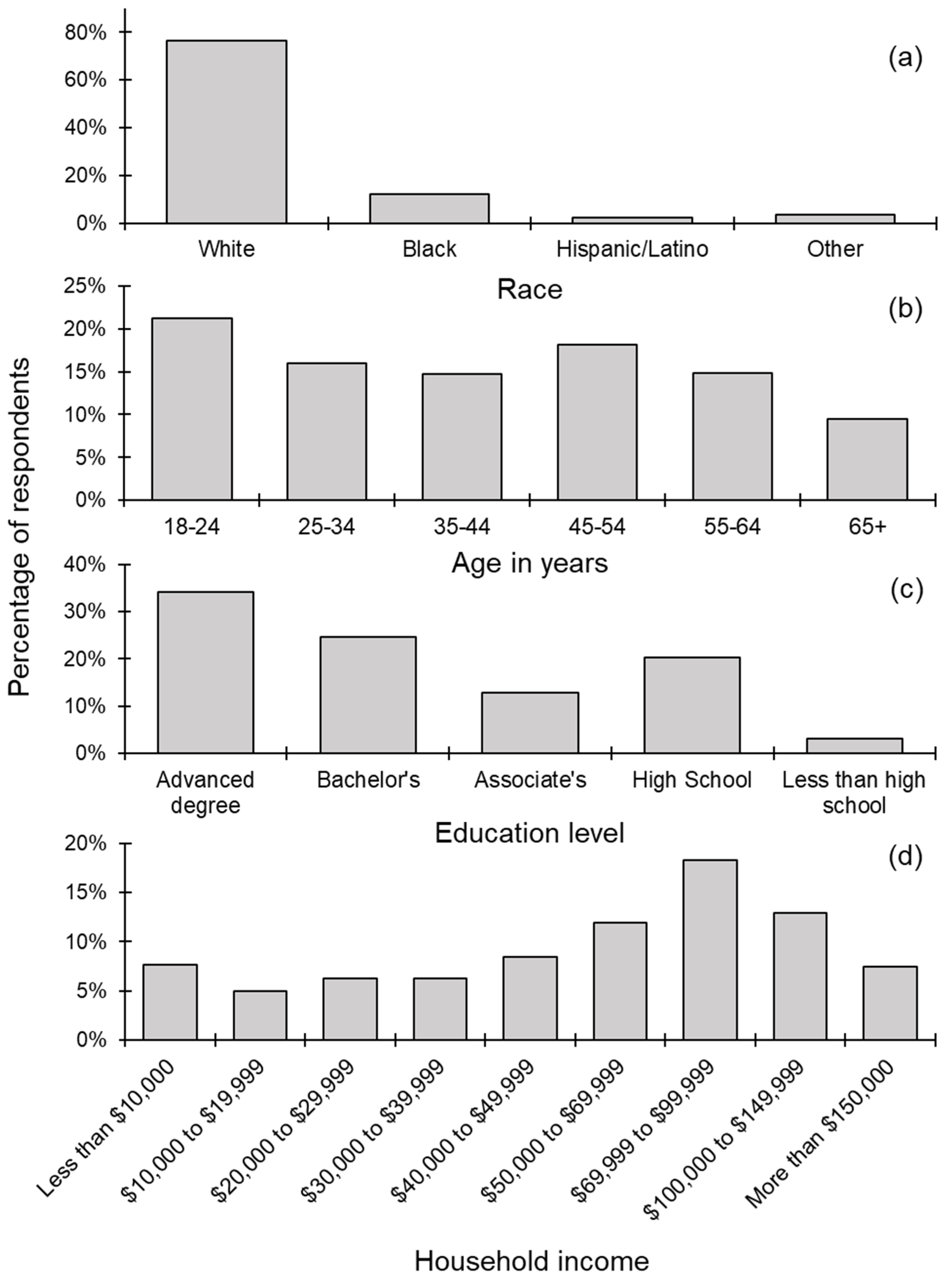
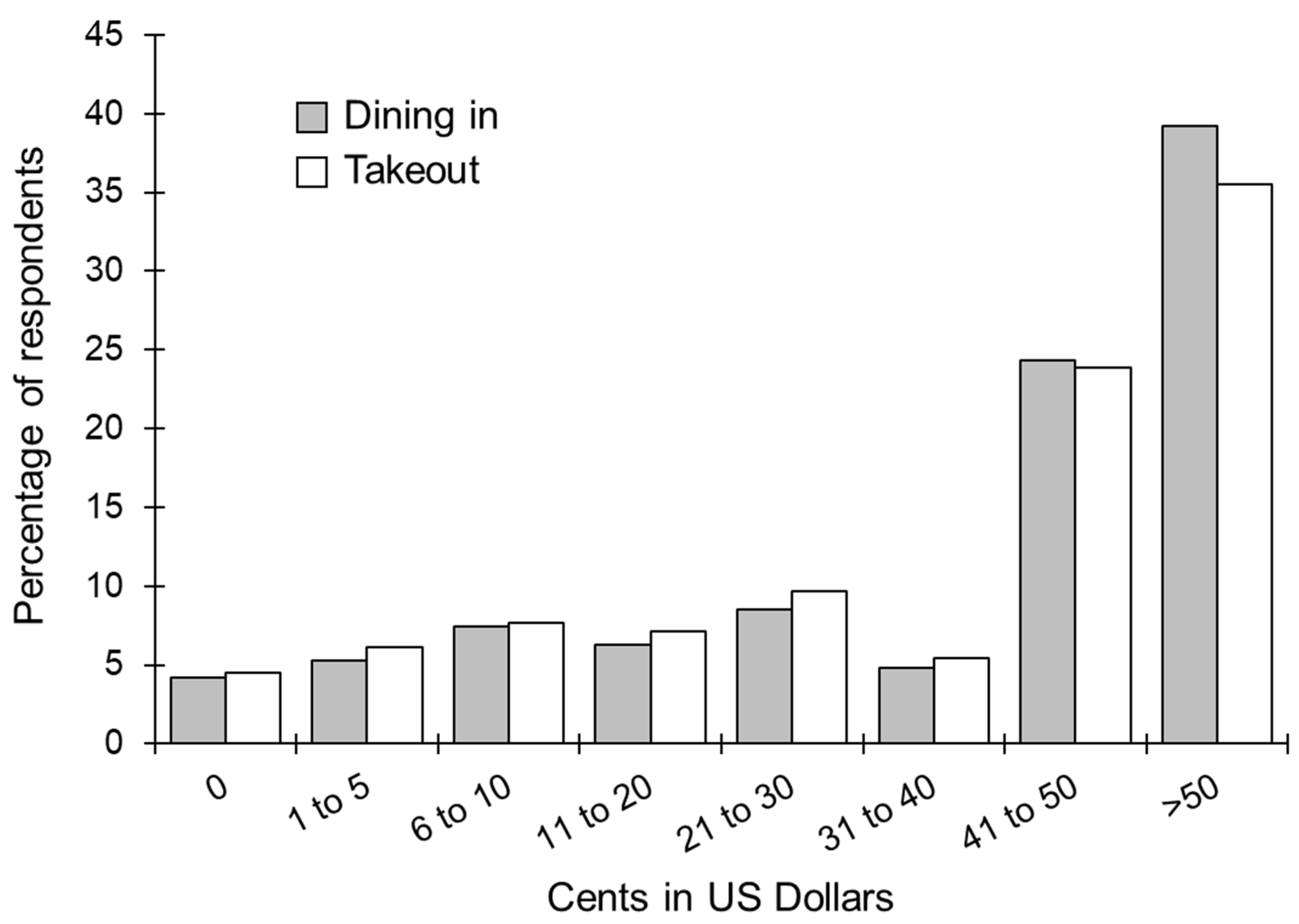
| Question | Eigenvalues | % of Variance | % Cumulative |
|---|---|---|---|
| 10 | 3.411 | 68.23 | 68.23 |
| 11 | 0.669 | 13.37 | 81.61 |
| 12 | 0.468 | 9.36 | 90.74 |
| 13 | 0.280 | 5.56 | 96.569 |
| 14 | 0.172 | 3.43 | 100.00 |
| Variable | Exp (B) | Significance Level or Comment |
|---|---|---|
| Environmental Identity | 1.802 | *** |
| Less than HS education | - | small sample size |
| Associates Degree | 1.186 | |
| Bachelor’s Degree | 1.473 | |
| Advanced Degree | 2.54 | *** |
| Black/African American | 0.631 | * |
| Latino/Hispanic | 0.238 | * |
| Other (race) | 0.95 | |
| Above median income | 0.981 | |
| Young (age 18–24) | 1.245 | |
| Old (age 65+) | 0.949 | |
| Female | 0.712 | * |
| n = 1011 a = sig in 1 tail t-test | ||
Publisher’s Note: MDPI stays neutral with regard to jurisdictional claims in published maps and institutional affiliations. |
© 2022 by the authors. Licensee MDPI, Basel, Switzerland. This article is an open access article distributed under the terms and conditions of the Creative Commons Attribution (CC BY) license (https://creativecommons.org/licenses/by/4.0/).
Share and Cite
Fischbach, E.; Sparks, E.; Hudson, K.; Lio, S.; Englebretson, E. Consumer Concern and Willingness to Pay for Plastic Alternatives in Food Service. Sustainability 2022, 14, 5992. https://doi.org/10.3390/su14105992
Fischbach E, Sparks E, Hudson K, Lio S, Englebretson E. Consumer Concern and Willingness to Pay for Plastic Alternatives in Food Service. Sustainability. 2022; 14(10):5992. https://doi.org/10.3390/su14105992
Chicago/Turabian StyleFischbach, Emily, Eric Sparks, Kenneth Hudson, Shoon Lio, and Elizabeth Englebretson. 2022. "Consumer Concern and Willingness to Pay for Plastic Alternatives in Food Service" Sustainability 14, no. 10: 5992. https://doi.org/10.3390/su14105992
APA StyleFischbach, E., Sparks, E., Hudson, K., Lio, S., & Englebretson, E. (2022). Consumer Concern and Willingness to Pay for Plastic Alternatives in Food Service. Sustainability, 14(10), 5992. https://doi.org/10.3390/su14105992







